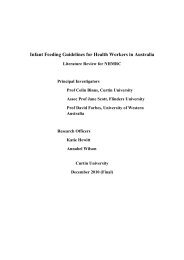FAILURE TO THRIVE - Flourish Paediatrics
FAILURE TO THRIVE - Flourish Paediatrics
FAILURE TO THRIVE - Flourish Paediatrics
Create successful ePaper yourself
Turn your PDF publications into a flip-book with our unique Google optimized e-Paper software.
Starship Children’s Health Clinical Guideline<br />
Note: The electronic version of this guideline is the version currently in use. Any printed version can<br />
not be assumed to be current. Please remember to read our disclaimer.<br />
<strong>FAILURE</strong> <strong>TO</strong> <strong>THRIVE</strong><br />
Developmental assessment is crucial: With non-organic failure to thrive all milestones are usually<br />
delayed by the time the infant reaches 4 months of age. Areas dependent upon environmental<br />
interactions, such as language development and social adaptation, are often disproportionately<br />
delayed.<br />
Common physical examination findings in non-organic failure to thrive:<br />
• Signs of failure to gain weight<br />
e.g. loss of fat, prominence of<br />
ribs, muscle wasting<br />
especially of large groups e.g.<br />
gluteals<br />
• Signs of poor hygiene<br />
• Infant very watchful and alert<br />
• Infant dislikes being touched or held<br />
• Lack of stranger anxiety<br />
• Toddler may indiscriminately seek<br />
affection<br />
• Developmental delay • Mild hepatomegaly<br />
• Apathetic and withdrawn<br />
behaviour<br />
• Minimal smiling and<br />
decreased vocalisation<br />
• Infant rarely cries but is<br />
hyperirritable<br />
• Hypertonia<br />
• Diminished muscle strength<br />
• Retention of tonic posturing<br />
Exclude organic disease: This requires a detailed history and examination. Laboratory<br />
investigations will add very little unless there are significant findings in the history and examination.<br />
Investigations that should be considered include: urinalysis (pH, osmolality, cellular elements,<br />
glucose, ketones), urine culture, stool for ova and parasites, full blood count, erythrocyte<br />
sedimentation rate, serum urea, creatinine, electrolytes, calcium and phosphorus, total protein,<br />
albumin, and liver enzymes and coeliac screening.<br />
Plan for Admission<br />
Children should be hospitalised for FTT when it persists despite maximisation of community<br />
support (community nurse, community dietician, social worker, whanau, church, etc.) or because<br />
characteristics of the child, care giver or family make such outpatient management inappropriate or<br />
place the child at risk of neglect or injury.<br />
The three aims of hospitalisation of children with FTT are:<br />
To observe the child's feeding behaviour and the mother-child interaction<br />
To see whether the infant's weight gain returns to normal when s/he is provided with adequate<br />
caloric intake and/or is removed from the family<br />
To decide whether further laboratory testing is indicated<br />
Planned Feeding Regimen<br />
The feeding regimen must be accurately charted and nutritional intake accurately recorded on a 24<br />
hour fluid balance sheet. The majority of children with FTT will consume > 130 kcal/kg/day. They<br />
should be offered a caloric intake 50% greater than required for normal growth by a child of the<br />
same height and of average weight. Average energy requirements are 110 kcal/kg/day for first 6<br />
months, 100 kcal/kg/day for second 6 months and subsequently to age 3.<br />
Severity of malnutrition can be determined by calculating the actual weight as a percentage of ideal<br />
weight for height. Normal is 90 to 110 percent<br />
Author: Dr Cameron Grant Service: General <strong>Paediatrics</strong><br />
Editor: Dr Raewyn Gavin Date Issued: Reviewed June 2005<br />
Failure to Thrive Page: 2 of 3









